Startup-Success-Prediction
import time
from selenium import webdriver
from bs4 import BeautifulSoup
import pandas as pd
import requests
from urllib.request import Request, urlopen
import json
import re
import glob
import os
import numpy as np
import matplotlib as mpl
from matplotlib import pyplot as plt
%matplotlib inline
import warnings
from decimal import Decimal
import math
import seaborn as sns
from scipy.stats import chi2_contingency
from scipy import misc
from matplotlib.colors import ListedColormap
import sklearn
from sklearn import metrics
from sklearn.model_selection import train_test_split
from sklearn import tree
from sklearn.model_selection import GridSearchCV
from sklearn.metrics import make_scorer
from sklearn.ensemble import RandomForestClassifier
from sklearn import linear_model, metrics, preprocessing
from sklearn.preprocessing import StandardScaler, MinMaxScaler
from sklearn.linear_model import LogisticRegression, LinearRegression
from sklearn.metrics import r2_score, f1_score
from sklearn.decomposition import PCA
from sklearn.preprocessing import MinMaxScaler
from sklearn.preprocessing import minmax_scale
from sklearn.neighbors import KNeighborsClassifier
from sklearn.model_selection import cross_val_score
from sklearn.naive_bayes import GaussianNB
from IPython.display import Image, display
from collections import Counter
import pydotplus
warnings.filterwarnings("ignore")
pd.set_option('display.max_rows', 500)
pd.set_option('display.max_columns', 500)
pd.set_option('display.width', 1000)
1.1 Scraping - Selenium Infinite Scrolling
html_companies_page = 'https://finder.startupnationcentral.org/startups/search'
def get_driver():
driver = webdriver.Firefox(executable_path=r'C:\Python34\geckodriver.exe')
driver.get(html_companies_page)
return driver
We couldnt get all pages with requests, so we had to use selenium to implement infinite scroll so we can get all companies urls and later on scrape data from this pages.
def infinite_scroll(driver):
time.sleep(2) # Allow 2 seconds for the web page to open
scroll_pause_time = 1
screen_height = driver.execute_script("return window.screen.height;") # get the screen height of the web
i = 2
while (i < 50):
# scroll one screen height each time
driver.execute_script("window.scrollTo(0, {screen_height}*{i});".format(screen_height=screen_height, i=i))
i += 1
time.sleep(scroll_pause_time)
scroll_height = driver.execute_script("return document.body.scrollHeight;")
driver = get_driver()
infinite_scroll(driver)
#linkedin login
driver = get_driver()
username = driver.find_element_by_id('username')
username.send_keys('yair.sultanv@gmail.com')
time.sleep(0.5)
password = driver.find_element_by_id('password')
password.send_keys('yairsultan')
time.sleep(0.5)
log_in_button = driver.find_element_by_class_name('btn__primary--large')
log_in_button.click()
time.sleep(3)
1.2 Scraping - Get Companies Urls
def load_soup_object(html_file_name):
html = open( html_file_name, encoding="utf8")
soup = BeautifulSoup(html, 'html.parser')
return soup
We had to split our requests to multiple files because after some time of infinite scorling we got blocked.
def extract_companies_urls(html_link):
html_link = "./Data/companies_urls/" + html_link
soup = load_soup_object(html_link)
companie_div = soup("div",attrs = {"class" : 'js-company-cards-list'})[0]
links = list()
for row in companie_div('div',attrs = {"class" : 'box-view-item'}):
url = row('a')[0]['href']
links.append(url)
return links
From each HTML page with multiple companies urls, we extracted the urls in to one big dataframe.

list_50_to_90 = extract_companies_urls('Start-Up1950-1990.html')
list_91_to_00 = extract_companies_urls('Start-Up1991-2000.html')
list_01_to_05 = extract_companies_urls('Start-Up2001-2005.html')
list_05_to_09 = extract_companies_urls('Start-Up2005-2009.html')
list_10_to_11 = extract_companies_urls('Start-Up2010-2011.html')
list_12 = extract_companies_urls('Start-Up2012.html')
list_13 = extract_companies_urls('Start-Up2013.html')
list_14 =extract_companies_urls('Start-Up2014.html')
list_15 = extract_companies_urls('Start-Up2015.html')
list_16 = extract_companies_urls('Start-Up2016.html')
list_17 = extract_companies_urls('Start-Up2017.html')
list_18 = extract_companies_urls('Start-Up2018.html')
list_19 = extract_companies_urls('Start-Up2018.html')
list_20_22 = extract_companies_urls('Start-Up2020-2022.html')
link_list = list_50_to_90 + list_91_to_00 +list_01_to_05+list_05_to_09+ list_10_to_11 + list_12+list_13 + list_14 +list_15 +list_16 +list_17 +list_18 + list_19 +list_20_22
df = pd.DataFrame({'links' : link_list})
df = df.drop_duplicates().copy()
df = df.reset_index(drop=True)
We ended up with csv file with more then 10,300 urls and saved it.
df.to_csv("companies_urls.csv",index = False)
1.3 Scraping - Company Page Scraping
def load_csv(fileName):
return pd.read_csv(fileName)
def load_soup_html(url):
html = requests.get(url)
soup = BeautifulSoup(html.text, 'html.parser')
return soup
Let’s load our urls csv from previous stage :
df = load_csv("companies_urls.csv")
Let’s define a function that extracts all of the features we want from the company page :
def get_df_companies(df):
res_df = pd.DataFrame(columns=['COMPANIE_NAME', 'FOUNDED', 'BUSINESS_MODEL', 'EMPLOYEES','FUNDING_STAGE','RAISED'
, 'PRODUCT_STAGE', 'NEWS_COUNT', 'FOUNDER_COUNT', 'TOTAL_ROUNDS', 'INVESTORS_COUNT'
, 'COMPANY_STATUS', 'IS_ACADEMIC', 'SECTOR', 'TARGET_INDUSTORY'])
for url in df['links']:
print(url)
soup = load_soup_html(url)
company_dict = {
"NAME": None,
"FOUNDED": None,
"BUSINESS MODEL": None,
"EMPLOYEES": None,
"FUNDING STAGE": None,
"RAISED": 0,
"PRODUCT STAGE": None,
"NEWS": 0,
"FOUNDERS": 0,
"Total rounds": 0,
"Investors": 0,
"STATUS": "Active",
"IS ACADEMIC": 0,
"SECTOR": None,
"TARGET INDUSTORY": None
}
name_div = soup("div",attrs = {"class" : 'top-profile-section'})
if(not name_div):
continue
company_dict["NAME"] = soup("div",attrs = {"class" : 'top-profile-section'})[0]("div",attrs = {"class" : 'title'})[0].get_text().strip()
COMPANY_PROFILE = soup("div",attrs = {"class" : 'metadata-wrapper'})
if(len(COMPANY_PROFILE)):
for div in COMPANY_PROFILE[0]("div",attrs = {"class" : 'item-bottom'}):
company_dict.update( {div.get_text().strip(): div.find_previous('div').get_text().strip()})
if(soup("div", attrs = {"id": "news-section"})):
news_div = soup("div", attrs = {"id": "news-section"})[0]
news_str = news_div("div", attrs = {"class": "section-text"})[0].get_text().strip()
company_dict["NEWS"] = int(re.findall('\d+', news_str)[0])
if(soup("div", attrs = {"id": "team-section"})):
team_div = soup("div", attrs = {"id": "team-section"})[0]
team_str = team_div("div", attrs = {"class": "section-text"})[0].get_text().strip()
company_dict["FOUNDERS"] = int(re.findall('\d+', team_str)[0])
FUNDING_DATA = soup("div",attrs = {"class" : 'funding-metadata'})
if(len(FUNDING_DATA)):
for div in FUNDING_DATA[0]("div",attrs = {"class" : 'subtitle'}):
funding_text = div.get_text().strip()
if(funding_text == 'Total rounds' or funding_text == 'Investors'):
company_dict[funding_text] = div.find_previous('div').get_text().strip()
if(soup.find_all("div", string=["Public"])):
company_dict["STATUS"] = "Public"
elif(soup.find_all("div", string=["Acquired by"])):
company_dict["STATUS"] = "Acquired"
elif(soup.find_all("div", string=["Not Active"])):
company_dict["STATUS"] = "Not Active"
if(soup.find_all("div", string=["Academic technology"])):
company_dict["IS ACADEMIC"] = 1
sector_div = soup.find_all("use", attrs={"xlink:href": "#icon-classification-sector"})
if(sector_div):
sector_div = sector_div[0].parent.parent.parent.parent("a", attrs = {"class": "lead-title"})
company_dict["SECTOR"] = sector_div[0].get_text().strip()
industry_div = soup.find_all("use", attrs={"xlink:href": "#icon-classification-industry"})
if(industry_div):
industry_div = industry_div[0].parent.parent.parent.parent("a", attrs = {"class": "lead-title"})
company_dict["TARGET INDUSTORY"] = industry_div[0].get_text().strip()
print(company_dict)
res_df.loc[len(res_df)] = list(company_dict.values())
return res_df



Now, we are going run in a loop, each iteration will include 100 companies data extracting and we will wait a few seconds so we wont get blocked.
Each iteration is saved in a seperate DataFrame so we can be in control all the time and check the data we are getting. (this step lasted about 48 hours)
for i in range(0,104):
df_res = get_df_companies(df.iloc[i*100: (i+1) * 100])
df_res.to_csv("Data\companies_df\companies_" + str(i*100) + "-" + str((i*100) + 99) + ".csv",index = False)
print("************************ file number:" + str(i) + "***********************\n\n")
time.sleep(10)
Now after we finished scraping all of the data, lets combine all the files to one big DataFrame :
path = r'Data\companies_df'
all_files = sorted(glob.glob(os.path.join(path, "*.csv")), key=os.path.getmtime) #get all files sorted by time modified asc
df_from_each_file = (pd.read_csv(f) for f in all_files)
concatenated_df = pd.concat(df_from_each_file, ignore_index=True)
# concatenated_df
filepath = r'Data\companies_df\main_df.csv'
concatenated_df.to_csv(filepath, index=False)
2. Data cleaning 🧹🧹🧹
main_df = pd.read_csv('Data/companies_df/main_df.csv')
main_df
| COMPANIE_NAME | FOUNDED | BUSINESS_MODEL | EMPLOYEES | FUNDING_STAGE | RAISED | PRODUCT_STAGE | NEWS_COUNT | FOUNDER_COUNT | TOTAL_ROUNDS | INVESTORS_COUNT | COMPANY_STATUS | IS_ACADEMIC | SECTOR | TARGET_INDUSTORY | |
|---|---|---|---|---|---|---|---|---|---|---|---|---|---|---|---|
| 0 | Golan Plastic Products | 1/1964 | B2B, B2G | 11-50 | Public | 0 | Released | 1 | 4 | 0 | 0 | Public | 0 | Industrial Technologies | Energy, Utilities & Waste Management |
| 1 | Cham Foods | 12/1970 | B2B, B2B2C | 11-50 | Public | 0 | Released | 2 | 2 | 0 | 0 | Public | 0 | AgriFood-tech & Water | Agriculture & Food |
| 2 | HerbaMed | 1/1986 | B2B, B2C | 1-10 | Revenue Financed | 0 | Released | 2 | 2 | 0 | 0 | Not Active | 0 | AgriFood-tech & Water | Agriculture & Food |
| 3 | RAD | 1/1981 | B2B, B2G | 500+ | Established | 0 | Released | 13 | 3 | 0 | 0 | Active | 0 | Industrial Technologies | Communication Services |
| 4 | RADA | 12/1970 | B2B, B2G | 201-500 | Public | $35.3M | Released | 31 | 6 | 2 | 5 | Public | 0 | Security Technologies | Defense, Safety & Security |
| ... | ... | ... | ... | ... | ... | ... | ... | ... | ... | ... | ... | ... | ... | ... | ... |
| 10373 | Expecting | 1/2021 | B2B, B2C | 11-50 | Seed | $1M | Released | 2 | 2 | 1 | 0 | Active | 0 | Life Sciences & HealthTech | Consumers |
| 10374 | Loona | 8/2020 | B2B | 1-10 | Bootstrapped | 0 | Customer development | 0 | 2 | 0 | 0 | Active | 0 | Enterprise, IT & Data Infrastructure | Industrial Manufacturing |
| 10375 | Quiz Beez | 6/2021 | B2C | 1-10 | Bootstrapped | 0 | Customer development | 0 | 1 | 0 | 0 | Active | 0 | Content & Media | Education |
| 10376 | Eureka Security | 10/2021 | B2B | 11-50 | Seed | $8M | Released | 2 | 2 | 1 | 7 | Active | 0 | Security Technologies | Enterprise & Professional Services |
| 10377 | Kitchezz | 11/2020 | B2B, B2C | 1-10 | Bootstrapped | 0 | Released | 0 | 2 | 0 | 0 | Active | 0 | Retail & Marketing | Commerce & Retail |
10378 rows × 15 columns
We can see that we have up to 709 None values in some columns, so we will start our data cleaning by using dropna.
main_df.isnull().sum(axis = 0)
COMPANIE_NAME 0
FOUNDED 376
BUSINESS_MODEL 467
EMPLOYEES 408
FUNDING_STAGE 709
RAISED 0
PRODUCT_STAGE 569
NEWS_COUNT 0
FOUNDER_COUNT 0
TOTAL_ROUNDS 0
INVESTORS_COUNT 0
COMPANY_STATUS 0
IS_ACADEMIC 0
SECTOR 343
TARGET_INDUSTORY 394
dtype: int64
main_df.dropna(inplace=True)
print(main_df.isnull().sum(axis = 0))
print(len(main_df))
COMPANIE_NAME 0
FOUNDED 0
BUSINESS_MODEL 0
EMPLOYEES 0
FUNDING_STAGE 0
RAISED 0
PRODUCT_STAGE 0
NEWS_COUNT 0
FOUNDER_COUNT 0
TOTAL_ROUNDS 0
INVESTORS_COUNT 0
COMPANY_STATUS 0
IS_ACADEMIC 0
SECTOR 0
TARGET_INDUSTORY 0
dtype: int64
9210
After removing Nan values we got total of 9210 rows.
main_df.drop_duplicates()
| COMPANIE_NAME | FOUNDED | BUSINESS_MODEL | EMPLOYEES | FUNDING_STAGE | RAISED | PRODUCT_STAGE | NEWS_COUNT | FOUNDER_COUNT | TOTAL_ROUNDS | INVESTORS_COUNT | COMPANY_STATUS | IS_ACADEMIC | SECTOR | TARGET_INDUSTORY | |
|---|---|---|---|---|---|---|---|---|---|---|---|---|---|---|---|
| 0 | Golan Plastic Products | 1/1964 | B2B, B2G | 11-50 | Public | 0 | Released | 1 | 4 | 0 | 0 | Public | 0 | Industrial Technologies | Energy, Utilities & Waste Management |
| 1 | Cham Foods | 12/1970 | B2B, B2B2C | 11-50 | Public | 0 | Released | 2 | 2 | 0 | 0 | Public | 0 | AgriFood-tech & Water | Agriculture & Food |
| 2 | HerbaMed | 1/1986 | B2B, B2C | 1-10 | Revenue Financed | 0 | Released | 2 | 2 | 0 | 0 | Not Active | 0 | AgriFood-tech & Water | Agriculture & Food |
| 3 | RAD | 1/1981 | B2B, B2G | 500+ | Established | 0 | Released | 13 | 3 | 0 | 0 | Active | 0 | Industrial Technologies | Communication Services |
| 4 | RADA | 12/1970 | B2B, B2G | 201-500 | Public | $35.3M | Released | 31 | 6 | 2 | 5 | Public | 0 | Security Technologies | Defense, Safety & Security |
| ... | ... | ... | ... | ... | ... | ... | ... | ... | ... | ... | ... | ... | ... | ... | ... |
| 10373 | Expecting | 1/2021 | B2B, B2C | 11-50 | Seed | $1M | Released | 2 | 2 | 1 | 0 | Active | 0 | Life Sciences & HealthTech | Consumers |
| 10374 | Loona | 8/2020 | B2B | 1-10 | Bootstrapped | 0 | Customer development | 0 | 2 | 0 | 0 | Active | 0 | Enterprise, IT & Data Infrastructure | Industrial Manufacturing |
| 10375 | Quiz Beez | 6/2021 | B2C | 1-10 | Bootstrapped | 0 | Customer development | 0 | 1 | 0 | 0 | Active | 0 | Content & Media | Education |
| 10376 | Eureka Security | 10/2021 | B2B | 11-50 | Seed | $8M | Released | 2 | 2 | 1 | 7 | Active | 0 | Security Technologies | Enterprise & Professional Services |
| 10377 | Kitchezz | 11/2020 | B2B, B2C | 1-10 | Bootstrapped | 0 | Released | 0 | 2 | 0 | 0 | Active | 0 | Retail & Marketing | Commerce & Retail |
9210 rows × 15 columns
We can see that after drop_duplicates function we still have 9210 rows which means our data scraping done optimally!!!
d = {'K': 3,'M': 6,'B': 9}
def text_to_num(text):
if text == '0':return 0
if text[-1] in d:
num, magnitude = text[1:-1], text[-1]
return int(float(num) * 10 ** d[magnitude])
else:
return int(0)
for idx, row in main_df.iterrows():
raised = text_to_num(row['RAISED'])
main_df.at[idx,'RAISED'] = raised
main_df["RAISED"] = pd.to_numeric(main_df["RAISED"])
main_df["RAISED"].describe().apply(lambda x: format(x, 'f'))
count 9210.000000
mean 9480790.375136
std 49695496.790866
min 0.000000
25% 0.000000
50% 0.000000
75% 1199000.000000
max 1247000000.000000
Name: RAISED, dtype: object
We need to seperate month and year from each string and push them into our dataframe.
def extract_month_and_year(val):
lst = val.split('/')
if len(lst) == 1:
lst.insert(0,0)
return int(lst[0]),int(lst[1])
months = list()
years = list()
for idx, row in main_df.iterrows():
month,year = extract_month_and_year(row['FOUNDED'])
months.append(month)
years.append(year)
main_df.insert(loc=2, column='FOUNDED_MONTH', value=months)
main_df.insert(loc=3, column='FOUNDED_YEAR', value=years)
main_df.drop(columns = ['FOUNDED'], axis=1, inplace=True)
main_df.describe()
| FOUNDED_MONTH | FOUNDED_YEAR | RAISED | NEWS_COUNT | FOUNDER_COUNT | TOTAL_ROUNDS | INVESTORS_COUNT | IS_ACADEMIC | |
|---|---|---|---|---|---|---|---|---|
| count | 9210.000000 | 9210.000000 | 9.210000e+03 | 9210.000000 | 9210.000000 | 9210.000000 | 9210.000000 | 9210.0 |
| mean | 4.998697 | 2011.541151 | 9.480790e+06 | 2.831813 | 2.618675 | 0.930293 | 1.358958 | 0.0 |
| std | 3.775316 | 9.305594 | 4.969550e+07 | 5.668288 | 1.685656 | 1.505888 | 2.841590 | 0.0 |
| min | 0.000000 | 1950.000000 | 0.000000e+00 | 0.000000 | 0.000000 | 0.000000 | 0.000000 | 0.0 |
| 25% | 1.000000 | 2010.000000 | 0.000000e+00 | 0.000000 | 1.250000 | 0.000000 | 0.000000 | 0.0 |
| 50% | 5.000000 | 2014.000000 | 0.000000e+00 | 1.000000 | 2.000000 | 0.000000 | 0.000000 | 0.0 |
| 75% | 8.000000 | 2017.000000 | 1.199000e+06 | 3.000000 | 3.000000 | 1.000000 | 1.000000 | 0.0 |
| max | 12.000000 | 2022.000000 | 1.247000e+09 | 98.000000 | 41.000000 | 16.000000 | 32.000000 | 0.0 |
Buisness model feature has 4 possible categories when there are companies that are characterized by several different models.
def extract_business_model(main_df):
b2b = list()
b2c = list()
b2g = list()
b2b2c = list()
for model in main_df['BUSINESS_MODEL']:
lst = model.split(', ')
b2b.append('B2B' in lst)
b2c.append('B2C' in lst)
b2g.append('B2G' in lst)
b2b2c.append('B2B2C' in lst)
return b2b, b2c, b2g ,b2b2c
b2b, b2c, b2g ,b2b2c = extract_business_model(main_df)
main_df.insert(loc=4, column='B2B', value=b2b)
main_df.insert(loc=5, column='B2C', value=b2c)
main_df.insert(loc=6, column='B2G', value=b2g)
main_df.insert(loc=7, column='B2B2C', value=b2b2c)
main_df['B2B'] = np.where(main_df['B2B'],1,0)
main_df['B2C'] = np.where(main_df['B2C'],1,0)
main_df['B2G'] = np.where(main_df['B2G'],1,0)
main_df['B2B2C'] = np.where(main_df['B2B2C'],1,0)
main_df.drop(columns = ['BUSINESS_MODEL'], axis=1, inplace=True)
def extract_company_status(main_df):
is_public = list()
is_acquired = list()
is_active = list()
is_notActive = list()
for status in main_df['COMPANY_STATUS']:
is_public.append('Public' == status)
is_acquired.append('Acquired' == status)
is_active.append('Active' == status)
is_notActive.append('Not Active' == status)
is_public = np.where(is_public,1,0)
is_acquired = np.where(is_acquired,1,0)
is_active = np.where(is_active,1,0)
is_notActive = np.where(is_notActive,1,0)
return is_public, is_acquired, is_active ,is_notActive
is_public, is_acquired, is_active ,is_notActive = extract_company_status(main_df)
main_df.insert(loc=16, column='IS_PUBLIC', value=is_public)
main_df.insert(loc=17, column='IS_ACQUIRED', value=is_acquired)
main_df.insert(loc=18, column='IS_ACTIVE', value=is_active)
main_df.insert(loc=19, column='IS_NOT_ACTIVE', value=is_notActive)
main_df.drop(columns = ['COMPANY_STATUS'], axis=1, inplace=True)
Let’s see what we got so far :
main_df
| COMPANIE_NAME | FOUNDED_MONTH | FOUNDED_YEAR | B2B | B2C | B2G | B2B2C | EMPLOYEES | FUNDING_STAGE | RAISED | ... | FOUNDER_COUNT | TOTAL_ROUNDS | INVESTORS_COUNT | IS_PUBLIC | IS_ACQUIRED | IS_ACTIVE | IS_NOT_ACTIVE | IS_ACADEMIC | SECTOR | TARGET_INDUSTORY | |
|---|---|---|---|---|---|---|---|---|---|---|---|---|---|---|---|---|---|---|---|---|---|
| 0 | Golan Plastic Products | 1 | 1964 | 1 | 0 | 1 | 0 | 11-50 | Public | 0 | ... | 4 | 0 | 0 | 1 | 0 | 0 | 0 | 0 | Industrial Technologies | Energy, Utilities & Waste Management |
| 1 | Cham Foods | 12 | 1970 | 1 | 0 | 0 | 1 | 11-50 | Public | 0 | ... | 2 | 0 | 0 | 1 | 0 | 0 | 0 | 0 | AgriFood-tech & Water | Agriculture & Food |
| 2 | HerbaMed | 1 | 1986 | 1 | 1 | 0 | 0 | 1-10 | Revenue Financed | 0 | ... | 2 | 0 | 0 | 0 | 0 | 0 | 1 | 0 | AgriFood-tech & Water | Agriculture & Food |
| 3 | RAD | 1 | 1981 | 1 | 0 | 1 | 0 | 500+ | Established | 0 | ... | 3 | 0 | 0 | 0 | 0 | 1 | 0 | 0 | Industrial Technologies | Communication Services |
| 4 | RADA | 12 | 1970 | 1 | 0 | 1 | 0 | 201-500 | Public | 35300000 | ... | 6 | 2 | 5 | 1 | 0 | 0 | 0 | 0 | Security Technologies | Defense, Safety & Security |
| ... | ... | ... | ... | ... | ... | ... | ... | ... | ... | ... | ... | ... | ... | ... | ... | ... | ... | ... | ... | ... | ... |
| 10373 | Expecting | 1 | 2021 | 1 | 1 | 0 | 0 | 11-50 | Seed | 1000000 | ... | 2 | 1 | 0 | 0 | 0 | 1 | 0 | 0 | Life Sciences & HealthTech | Consumers |
| 10374 | Loona | 8 | 2020 | 1 | 0 | 0 | 0 | 1-10 | Bootstrapped | 0 | ... | 2 | 0 | 0 | 0 | 0 | 1 | 0 | 0 | Enterprise, IT & Data Infrastructure | Industrial Manufacturing |
| 10375 | Quiz Beez | 6 | 2021 | 0 | 1 | 0 | 0 | 1-10 | Bootstrapped | 0 | ... | 1 | 0 | 0 | 0 | 0 | 1 | 0 | 0 | Content & Media | Education |
| 10376 | Eureka Security | 10 | 2021 | 1 | 0 | 0 | 0 | 11-50 | Seed | 8000000 | ... | 2 | 1 | 7 | 0 | 0 | 1 | 0 | 0 | Security Technologies | Enterprise & Professional Services |
| 10377 | Kitchezz | 11 | 2020 | 1 | 1 | 0 | 0 | 1-10 | Bootstrapped | 0 | ... | 2 | 0 | 0 | 0 | 0 | 1 | 0 | 0 | Retail & Marketing | Commerce & Retail |
9210 rows × 22 columns
main_df.describe(include='all')
| COMPANIE_NAME | FOUNDED_MONTH | FOUNDED_YEAR | B2B | B2C | B2G | B2B2C | EMPLOYEES | FUNDING_STAGE | RAISED | ... | FOUNDER_COUNT | TOTAL_ROUNDS | INVESTORS_COUNT | IS_PUBLIC | IS_ACQUIRED | IS_ACTIVE | IS_NOT_ACTIVE | IS_ACADEMIC | SECTOR | TARGET_INDUSTORY | |
|---|---|---|---|---|---|---|---|---|---|---|---|---|---|---|---|---|---|---|---|---|---|
| count | 9210 | 9210.000000 | 9210.000000 | 9210.000000 | 9210.000000 | 9210.000000 | 9210.000000 | 9210 | 9210 | 9.210000e+03 | ... | 9210.000000 | 9210.000000 | 9210.000000 | 9210.000000 | 9210.000000 | 9210.000000 | 9210.000000 | 9210.0 | 9210 | 9210 |
| unique | 9199 | NaN | NaN | NaN | NaN | NaN | NaN | 5 | 10 | NaN | ... | NaN | NaN | NaN | NaN | NaN | NaN | NaN | NaN | 11 | 17 |
| top | Amigo | NaN | NaN | NaN | NaN | NaN | NaN | 1-10 | Bootstrapped | NaN | ... | NaN | NaN | NaN | NaN | NaN | NaN | NaN | NaN | Life Sciences & HealthTech | Consumers |
| freq | 2 | NaN | NaN | NaN | NaN | NaN | NaN | 5694 | 2655 | NaN | ... | NaN | NaN | NaN | NaN | NaN | NaN | NaN | NaN | 1660 | 2640 |
| mean | NaN | 4.998697 | 2011.541151 | 0.790662 | 0.338436 | 0.154397 | 0.145168 | NaN | NaN | 9.480790e+06 | ... | 2.618675 | 0.930293 | 1.358958 | 0.035722 | 0.095331 | 0.585125 | 0.283822 | 0.0 | NaN | NaN |
| std | NaN | 3.775316 | 9.305594 | 0.406858 | 0.473203 | 0.361349 | 0.352290 | NaN | NaN | 4.969550e+07 | ... | 1.685656 | 1.505888 | 2.841590 | 0.185606 | 0.293688 | 0.492727 | 0.450876 | 0.0 | NaN | NaN |
| min | NaN | 0.000000 | 1950.000000 | 0.000000 | 0.000000 | 0.000000 | 0.000000 | NaN | NaN | 0.000000e+00 | ... | 0.000000 | 0.000000 | 0.000000 | 0.000000 | 0.000000 | 0.000000 | 0.000000 | 0.0 | NaN | NaN |
| 25% | NaN | 1.000000 | 2010.000000 | 1.000000 | 0.000000 | 0.000000 | 0.000000 | NaN | NaN | 0.000000e+00 | ... | 1.250000 | 0.000000 | 0.000000 | 0.000000 | 0.000000 | 0.000000 | 0.000000 | 0.0 | NaN | NaN |
| 50% | NaN | 5.000000 | 2014.000000 | 1.000000 | 0.000000 | 0.000000 | 0.000000 | NaN | NaN | 0.000000e+00 | ... | 2.000000 | 0.000000 | 0.000000 | 0.000000 | 0.000000 | 1.000000 | 0.000000 | 0.0 | NaN | NaN |
| 75% | NaN | 8.000000 | 2017.000000 | 1.000000 | 1.000000 | 0.000000 | 0.000000 | NaN | NaN | 1.199000e+06 | ... | 3.000000 | 1.000000 | 1.000000 | 0.000000 | 0.000000 | 1.000000 | 1.000000 | 0.0 | NaN | NaN |
| max | NaN | 12.000000 | 2022.000000 | 1.000000 | 1.000000 | 1.000000 | 1.000000 | NaN | NaN | 1.247000e+09 | ... | 41.000000 | 16.000000 | 32.000000 | 1.000000 | 1.000000 | 1.000000 | 1.000000 | 0.0 | NaN | NaN |
11 rows × 22 columns
print("Number of companies with IS_ACADEMIC = True : ",sum(main_df['IS_ACADEMIC']==1))
main_df.drop(columns = ['IS_ACADEMIC'], axis=1, inplace=True)
Number of companies with IS_ACADEMIC = True : 0
Let's look at our unique values :
print(main_df['FUNDING_STAGE'].unique())
print(main_df['EMPLOYEES'].unique())
print(main_df['PRODUCT_STAGE'].unique())
['Public' 'Revenue Financed' 'Established' 'ROUND A' 'ROUND C+' 'Acquired'
'Seed' 'ROUND B' 'Bootstrapped' 'Pre-Seed']
['11-50' '1-10' '500+' '201-500' '51-200']
['Released' 'Clinical Trial' 'R&D' 'Beta' 'Alpha' 'Customer development']
len(main_df[main_df['FUNDING_STAGE'] == 'Acquired'].index)
8
main_df.drop(main_df[main_df.FUNDING_STAGE == 'Acquired'].index, inplace=True)
employees_replace_map = {'1-10': 0, '11-50': 1, '51-200': 2, '201-500': 3, '500+': 4}
main_df['EMPLOYEES'].replace(employees_replace_map, inplace=True)
funding_replace_map = {'Bootstrapped': 0, 'Pre-Seed': 1, 'Seed': 2, 'ROUND A': 3, 'ROUND B': 4, 'ROUND C+': 5, 'Public': 6, 'Revenue Financed': 7, 'Established': 8}
main_df['FUNDING_STAGE'].replace(funding_replace_map, inplace=True)
stage_replace_map = {'Customer development': 0, 'R&D': 1, 'Clinical Trial': 2, 'Alpha': 3, 'Beta': 4, 'Released': 5}
main_df['PRODUCT_STAGE'].replace(stage_replace_map, inplace=True)
sector_replace_map = dict( enumerate(main_df['SECTOR'].astype('category').cat.categories ))
main_df['SECTOR'].replace(sector_replace_map, inplace=True)
print(sector_replace_map)
target_replace_map = dict( enumerate(main_df['TARGET_INDUSTORY'].astype('category').cat.categories ))
main_df['TARGET_INDUSTORY'].replace(target_replace_map, inplace=True)
print(target_replace_map)
{0: 'Aerospace & Aviation', 1: 'AgriFood-tech & Water', 2: 'Content & Media', 3: 'Energy-tech', 4: 'Enterprise, IT & Data Infrastructure', 5: 'FinTech', 6: 'Industrial Technologies', 7: 'Life Sciences & HealthTech', 8: 'Retail & Marketing', 9: 'Security Technologies', 10: 'Smart Mobility'}
{0: 'Agriculture & Food', 1: 'Commerce & Retail', 2: 'Communication Services', 3: 'Consumers', 4: 'Defense, Safety & Security', 5: 'Education', 6: 'Energy, Utilities & Waste Management', 7: 'Enterprise & Professional Services', 8: 'Financial Services', 9: 'Food Retail & Consumption', 10: 'Government & City', 11: 'Healthcare & Life Sciences', 12: 'Industrial Manufacturing', 13: 'Media & Entertainment', 14: 'Real Estate & Construction', 15: 'Transportation & Logistics', 16: 'Travel & Tourism'}
def get_age(year_list, month_list):
age = list()
for year, month in zip(year_list, month_list):
age.append((2022 - year) * 365 + (6 - month) * 30)
return age
main_df.loc[main_df['FOUNDED_MONTH'] == 0, ['FOUNDED_MONTH']] = round(main_df['FOUNDED_MONTH'].mean())
age = get_age(main_df['FOUNDED_YEAR'], main_df['FOUNDED_MONTH'])
main_df.insert(loc=3, column='AGE', value=age)
main_df
| COMPANIE_NAME | FOUNDED_MONTH | FOUNDED_YEAR | AGE | B2B | B2C | B2G | B2B2C | EMPLOYEES | FUNDING_STAGE | ... | NEWS_COUNT | FOUNDER_COUNT | TOTAL_ROUNDS | INVESTORS_COUNT | IS_PUBLIC | IS_ACQUIRED | IS_ACTIVE | IS_NOT_ACTIVE | SECTOR | TARGET_INDUSTORY | |
|---|---|---|---|---|---|---|---|---|---|---|---|---|---|---|---|---|---|---|---|---|---|
| 0 | Golan Plastic Products | 1 | 1964 | 21320 | 1 | 0 | 1 | 0 | 1 | 6 | ... | 1 | 4 | 0 | 0 | 1 | 0 | 0 | 0 | Industrial Technologies | Energy, Utilities & Waste Management |
| 1 | Cham Foods | 12 | 1970 | 18800 | 1 | 0 | 0 | 1 | 1 | 6 | ... | 2 | 2 | 0 | 0 | 1 | 0 | 0 | 0 | AgriFood-tech & Water | Agriculture & Food |
| 2 | HerbaMed | 1 | 1986 | 13290 | 1 | 1 | 0 | 0 | 0 | 7 | ... | 2 | 2 | 0 | 0 | 0 | 0 | 0 | 1 | AgriFood-tech & Water | Agriculture & Food |
| 3 | RAD | 1 | 1981 | 15115 | 1 | 0 | 1 | 0 | 4 | 8 | ... | 13 | 3 | 0 | 0 | 0 | 0 | 1 | 0 | Industrial Technologies | Communication Services |
| 4 | RADA | 12 | 1970 | 18800 | 1 | 0 | 1 | 0 | 3 | 6 | ... | 31 | 6 | 2 | 5 | 1 | 0 | 0 | 0 | Security Technologies | Defense, Safety & Security |
| ... | ... | ... | ... | ... | ... | ... | ... | ... | ... | ... | ... | ... | ... | ... | ... | ... | ... | ... | ... | ... | ... |
| 10373 | Expecting | 1 | 2021 | 515 | 1 | 1 | 0 | 0 | 1 | 2 | ... | 2 | 2 | 1 | 0 | 0 | 0 | 1 | 0 | Life Sciences & HealthTech | Consumers |
| 10374 | Loona | 8 | 2020 | 670 | 1 | 0 | 0 | 0 | 0 | 0 | ... | 0 | 2 | 0 | 0 | 0 | 0 | 1 | 0 | Enterprise, IT & Data Infrastructure | Industrial Manufacturing |
| 10375 | Quiz Beez | 6 | 2021 | 365 | 0 | 1 | 0 | 0 | 0 | 0 | ... | 0 | 1 | 0 | 0 | 0 | 0 | 1 | 0 | Content & Media | Education |
| 10376 | Eureka Security | 10 | 2021 | 245 | 1 | 0 | 0 | 0 | 1 | 2 | ... | 2 | 2 | 1 | 7 | 0 | 0 | 1 | 0 | Security Technologies | Enterprise & Professional Services |
| 10377 | Kitchezz | 11 | 2020 | 580 | 1 | 1 | 0 | 0 | 0 | 0 | ... | 0 | 2 | 0 | 0 | 0 | 0 | 1 | 0 | Retail & Marketing | Commerce & Retail |
9202 rows × 22 columns
3. Outliers 🤥⛔
In this secion, we are going to:
- Detect Outliers and present them by using boxplots for the next features:
- RAISED
- NEWS_COUNT
- FOUNDER_COUNT
- INVESTORS_COUNT
- We are going to use Z-score and IQR and select what seems best for us.
sns.boxplot(main_df.RAISED)
plt.show()
sns.boxplot(main_df.NEWS_COUNT)
plt.show()
sns.boxplot(main_df.FOUNDER_COUNT)
plt.show()
sns.boxplot(main_df.INVESTORS_COUNT)
plt.show()
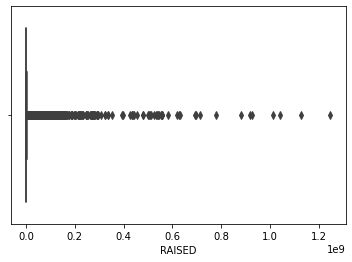
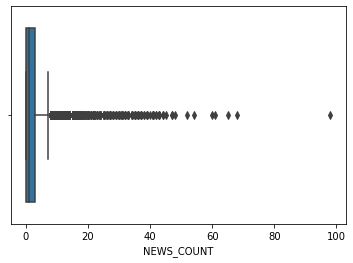
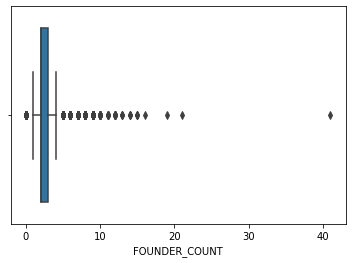
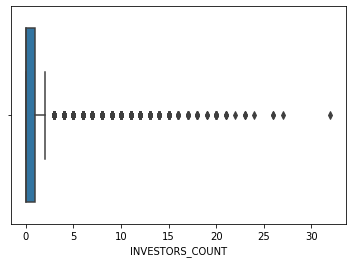
‘RAISED’
Q1 = np.percentile(main_df["RAISED"], 25)
Q3 = np.percentile(main_df["RAISED"], 75)
IQR = Q3 - Q1
print(f"IQR value: {IQR}\nQ1 value: {Q1}\nQ3 value: {Q3}")
Fare_outlier_rows = main_df[(main_df["RAISED"] < Q1 - 1.5*IQR) | (main_df["RAISED"] > Q3 + 1.5*IQR )].index
print("Total sum of outliers detected: ",len(Fare_outlier_rows))
IQR value: 1200000.0
Q1 value: 0.0
Q3 value: 1200000.0
Total sum of outliers detected: 1763
With IQR we got 1763 outliers which is too many, lets try z-score:
z_score = (main_df["RAISED"] - main_df["RAISED"].mean()) / main_df["RAISED"].std()
outliers = abs(z_score) > 3
print("Total outliers: ", sum(outliers))
main_df.drop(main_df[outliers].index, axis=0, inplace=True)
print("110 outliers are much better for us so we will use z-score")
Total outliers: 110
110 outliers are much better for us so we will use z-score
‘NEWS_COUNT’
z_score = (main_df["NEWS_COUNT"] - main_df["NEWS_COUNT"].mean()) / main_df["NEWS_COUNT"].std()
outliers = abs(z_score) > 4
print("Total outliers: ", sum(outliers))
main_df.drop(main_df[outliers].index, axis=0, inplace=True)
Total outliers: 111
‘FOUNDER_COUNT’
z_score = (main_df["FOUNDER_COUNT"] - main_df["FOUNDER_COUNT"].mean()) / main_df["FOUNDER_COUNT"].std()
outliers = abs(z_score) > 4
print("Total outliers: ", sum(outliers))
main_df.drop(main_df[outliers].index, axis=0, inplace=True)
Total outliers: 54
‘INVESTORS_COUNT’
z_score = (main_df["INVESTORS_COUNT"] - main_df["INVESTORS_COUNT"].mean()) / main_df["INVESTORS_COUNT"].std()
outliers = abs(z_score) > 4
print("Total outliers: ", sum(outliers))
main_df.drop(main_df[outliers].index, axis=0, inplace=True)
Total outliers: 106
Let’s look at our features after cleaning outliers:
sns.boxplot(main_df.RAISED)
plt.show()
sns.boxplot(main_df.NEWS_COUNT)
plt.show()
sns.boxplot(main_df.FOUNDER_COUNT)
plt.show()
sns.boxplot(main_df.INVESTORS_COUNT)
plt.show()
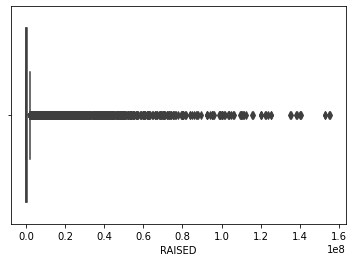
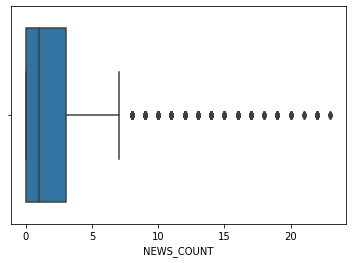
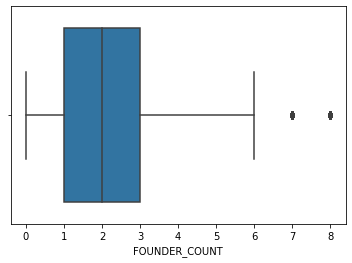
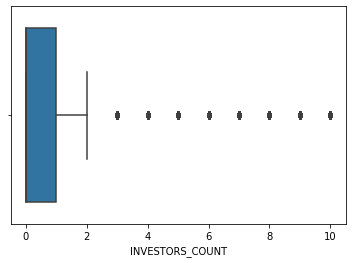
Data cleaning is finished, le'ts fix our indexes and save the final data frame.
main_df.reset_index(inplace=True)
main_df
| index | COMPANIE_NAME | FOUNDED_MONTH | FOUNDED_YEAR | AGE | B2B | B2C | B2G | B2B2C | EMPLOYEES | ... | NEWS_COUNT | FOUNDER_COUNT | TOTAL_ROUNDS | INVESTORS_COUNT | IS_PUBLIC | IS_ACQUIRED | IS_ACTIVE | IS_NOT_ACTIVE | SECTOR | TARGET_INDUSTORY | |
|---|---|---|---|---|---|---|---|---|---|---|---|---|---|---|---|---|---|---|---|---|---|
| 0 | 0 | Golan Plastic Products | 1 | 1964 | 21320 | 1 | 0 | 1 | 0 | 1 | ... | 1 | 4 | 0 | 0 | 1 | 0 | 0 | 0 | Industrial Technologies | Energy, Utilities & Waste Management |
| 1 | 1 | Cham Foods | 12 | 1970 | 18800 | 1 | 0 | 0 | 1 | 1 | ... | 2 | 2 | 0 | 0 | 1 | 0 | 0 | 0 | AgriFood-tech & Water | Agriculture & Food |
| 2 | 2 | HerbaMed | 1 | 1986 | 13290 | 1 | 1 | 0 | 0 | 0 | ... | 2 | 2 | 0 | 0 | 0 | 0 | 0 | 1 | AgriFood-tech & Water | Agriculture & Food |
| 3 | 3 | RAD | 1 | 1981 | 15115 | 1 | 0 | 1 | 0 | 4 | ... | 13 | 3 | 0 | 0 | 0 | 0 | 1 | 0 | Industrial Technologies | Communication Services |
| 4 | 5 | Ham-Let | 5 | 1950 | 26310 | 1 | 0 | 0 | 0 | 3 | ... | 7 | 4 | 0 | 0 | 0 | 1 | 0 | 0 | Industrial Technologies | Energy, Utilities & Waste Management |
| ... | ... | ... | ... | ... | ... | ... | ... | ... | ... | ... | ... | ... | ... | ... | ... | ... | ... | ... | ... | ... | ... |
| 8816 | 10373 | Expecting | 1 | 2021 | 515 | 1 | 1 | 0 | 0 | 1 | ... | 2 | 2 | 1 | 0 | 0 | 0 | 1 | 0 | Life Sciences & HealthTech | Consumers |
| 8817 | 10374 | Loona | 8 | 2020 | 670 | 1 | 0 | 0 | 0 | 0 | ... | 0 | 2 | 0 | 0 | 0 | 0 | 1 | 0 | Enterprise, IT & Data Infrastructure | Industrial Manufacturing |
| 8818 | 10375 | Quiz Beez | 6 | 2021 | 365 | 0 | 1 | 0 | 0 | 0 | ... | 0 | 1 | 0 | 0 | 0 | 0 | 1 | 0 | Content & Media | Education |
| 8819 | 10376 | Eureka Security | 10 | 2021 | 245 | 1 | 0 | 0 | 0 | 1 | ... | 2 | 2 | 1 | 7 | 0 | 0 | 1 | 0 | Security Technologies | Enterprise & Professional Services |
| 8820 | 10377 | Kitchezz | 11 | 2020 | 580 | 1 | 1 | 0 | 0 | 0 | ... | 0 | 2 | 0 | 0 | 0 | 0 | 1 | 0 | Retail & Marketing | Commerce & Retail |
8821 rows × 23 columns
main_df.to_csv('Data/companies_df/clean_df.csv', index=False)
4. EDA 📊📈📉
df = pd.read_csv('Data/companies_df/clean_df.csv')
df_raised_money = df[df['RAISED'] > 0]
df_didnt_raised_money = df[df['RAISED'] == 0]
print("Total number of companies after cleaning the data: ", len(df))
print("Number of companies who raised money: ",len(df_raised_money))
print("Number of companies who raised money: ",len(df_didnt_raised_money))
Total number of companies after cleaning the data: 8821
Number of companies who raised money: 2905
Number of companies who raised money: 5916
Let’s look at the Status distribution of companies with RAISED money value
fig, axs = plt.subplots(1,3)
fig.subplots_adjust(0.3,0,3,2)
labels = ['IS_PUBLIC', 'IS_ACTIVE', 'IS_ACQUIRED', 'IS_NOT_ACTIVE']
sizes = [len(df[df['IS_PUBLIC'] == 1]), len(df[df['IS_ACTIVE'] == 1]),len(df[df['IS_ACQUIRED'] == 1]), len(df[df['IS_NOT_ACTIVE'] == 1])]
axs[0].pie(sizes, labels=labels,autopct='%1.1f%%', shadow=True)
axs[0].set_title("All companies", bbox={'facecolor':'0.8', 'pad':5})
sizes_raised = [len(df_raised_money[df_raised_money['IS_PUBLIC'] == 1]), len(df_raised_money[df_raised_money['IS_ACTIVE'] == 1]),len(df_raised_money[df_raised_money['IS_ACQUIRED'] == 1]), len(df_raised_money[df_raised_money['IS_NOT_ACTIVE'] == 1])]
axs[1].pie(sizes_raised, labels=labels,autopct='%1.1f%%', shadow=True)
axs[1].set_title("Companies with Raised value", bbox={'facecolor':'0.8', 'pad':5})
sizes_didnt_raised = [len(df_didnt_raised_money[df_didnt_raised_money['IS_PUBLIC'] == 1]), len(df_didnt_raised_money[df_didnt_raised_money['IS_ACTIVE'] == 1]),len(df_didnt_raised_money[df_didnt_raised_money['IS_ACQUIRED'] == 1]), len(df_didnt_raised_money[df_didnt_raised_money['IS_NOT_ACTIVE'] == 1])]
axs[2].pie(sizes_didnt_raised, labels=labels,autopct='%1.1f%%', shadow=True)
axs[2].set_title("Companies without Raised value", bbox={'facecolor':'0.8', 'pad':5})
plt.show()

As we can see, companies who raised money are more likely to be aquired or public.
Let’s define what a successful company is:
## - If the company is acquired or public we will consider it a successful company.
df_succeeded_companies = df[(df.IS_ACQUIRED == 1) | (df.IS_PUBLIC == 1)]
df_unsucceeded_companies = df[(df.IS_ACQUIRED == 0) & (df.IS_PUBLIC == 0)]
print("The number of succeeded companies is: ",len(df_succeeded_companies))
print("The number of unSucceeded companies is: ",len(df_unsucceeded_companies))
The number of succeeded companies is: 1073
The number of unSucceeded companies is: 7748
After we defined what a successful company is, we need to convert our 4 status columns to ‘is_successful’ column.
def extract_company_status(main_df):
is_successful = list()
for index, row in df.iterrows():
if(row['IS_PUBLIC'] | row['IS_ACQUIRED']):
is_successful.append(1)
else:
is_successful.append(0)
return is_successful
is_successful = extract_company_status(df)
df.insert(loc=16, column='IS_SUCCESSFUL', value=is_successful)
df.drop(columns = ['IS_PUBLIC'], axis=1, inplace=True)
df.drop(columns = ['IS_ACQUIRED'], axis=1, inplace=True)
df.drop(columns = ['IS_ACTIVE'], axis=1, inplace=True)
df.drop(columns = ['IS_NOT_ACTIVE'], axis=1, inplace=True)
df.drop(columns = ['COMPANIE_NAME'], axis=1, inplace=True)
We will now examine whether the number of employees affects the company’s success.
ct = pd.crosstab(df['EMPLOYEES'], (df['IS_SUCCESSFUL']), normalize="index")
ax = ct.plot(kind="bar", figsize=(18,6), label=["1-10","11-50","51-200","201-500","500+"])
ax.legend(["Unsuccessful", "Successful"],fancybox=True, framealpha=1, shadow=True, borderpad=1)
for container in ax.containers:
ax.bar_label(container)
plt.title("Number of employees in successful companies", fontsize = 20)
plt.ylabel("Relative frequency")
Text(0, 0.5, 'Relative frequency')
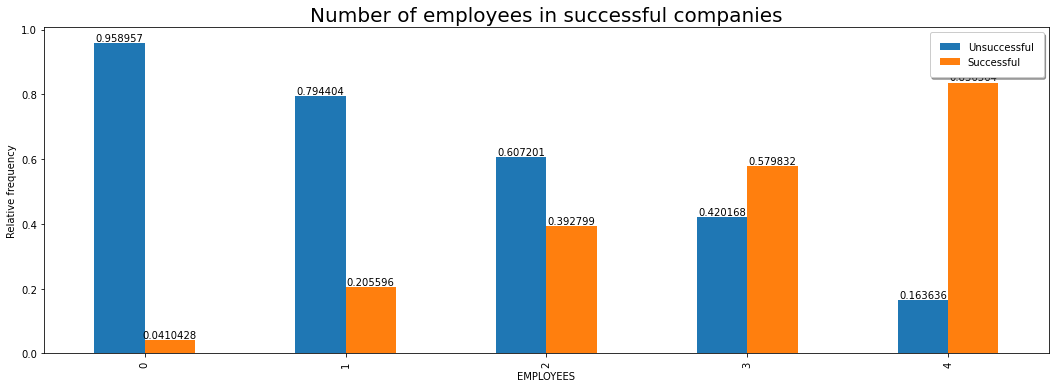
It can certainly be seen that the larger the number of employees, the greater the chances of success.
We tried to check if there is a relationship between the age of a company and the number of company investors
x = df_raised_money.AGE
y = df_raised_money.RAISED
A = np.vstack([x, np.ones(len(x))]).T
y = y[:, np.newaxis]
alpha = np.dot((np.dot(np.linalg.inv(np.dot(A.T,A)),A.T)),y)
plt.figure(figsize = (8,6))
plt.plot(x, y, 'b.')
plt.plot(x, alpha[0]*x + alpha[1], 'r')
plt.xlabel('Age in days')
plt.ylabel('Amount of money raised in Billion $')
plt.show()
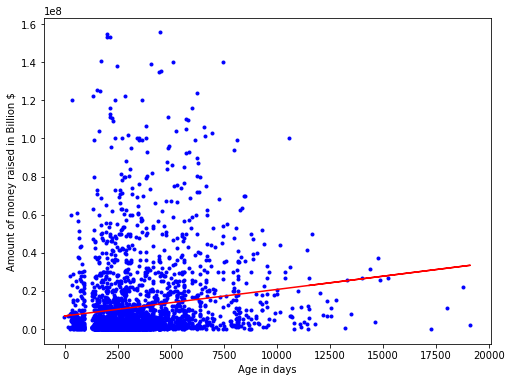
From the graph it can be seen that there is a real connection between the age of the company in days and the amount of money that the company raised. It can be understood from this graph that the longer a company exists, the more likely it is to raise money. And as we have seen before, companies that raise money are more likely to succeed.
We are now trying to test relationships and behaviors between quantitative variables. *
- We chose to take the columns:
~EMPLOYEES
~NEWS_COUNT
~FOUNDER_COUNT
~INVESTORS_COUNT
corr = df[['EMPLOYEES', 'NEWS_COUNT', 'FOUNDER_COUNT','INVESTORS_COUNT']].corr()
mask = np.zeros_like(corr)
with sns.axes_style("darkgrid"):
f, ax = plt.subplots(figsize=(15, 15))
ax = sns.heatmap(corr, mask=mask, vmax=1, square=True,annot=True)
# df = pd.DataFrame(df)
# sns.heatmap(df.corr(), annot=True)
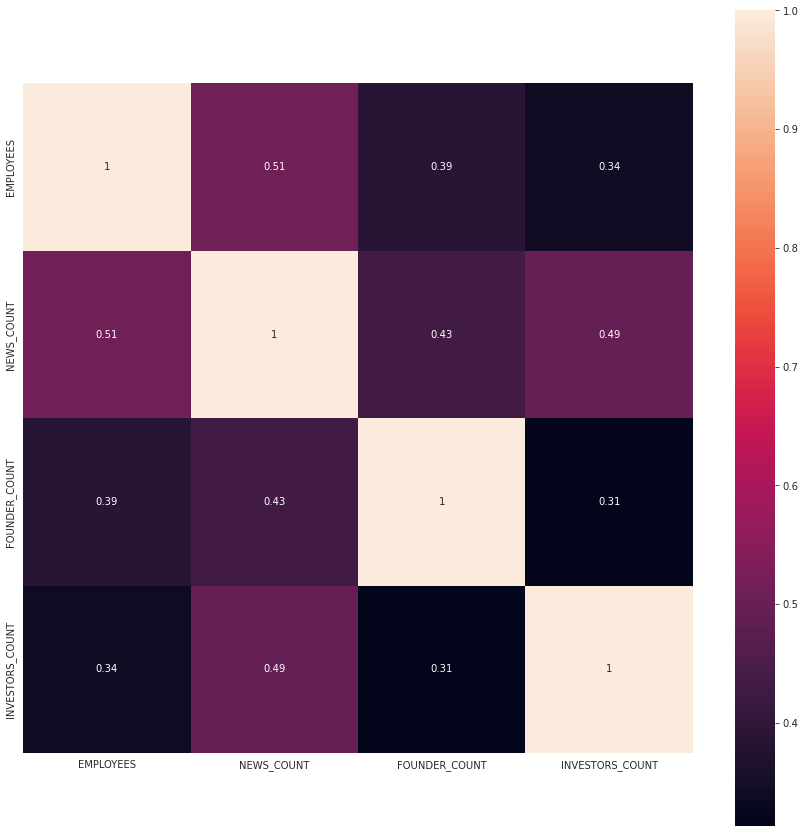
We were able to find out that there is a strong connection between the number of employees in the company and the number of news articles about the company.
ct2 = pd.crosstab(df[(df['RAISED'] == 0)]['TARGET_INDUSTORY'], df[(df['RAISED'] == 0)]['SECTOR'])
ct2
| SECTOR | Aerospace & Aviation | AgriFood-tech & Water | Content & Media | Energy-tech | Enterprise, IT & Data Infrastructure | FinTech | Industrial Technologies | Life Sciences & HealthTech | Retail & Marketing | Security Technologies | Smart Mobility |
|---|---|---|---|---|---|---|---|---|---|---|---|
| TARGET_INDUSTORY | |||||||||||
| Agriculture & Food | 11 | 343 | 1 | 10 | 11 | 3 | 34 | 8 | 1 | 4 | 4 |
| Commerce & Retail | 1 | 8 | 53 | 10 | 86 | 20 | 44 | 61 | 189 | 19 | 10 |
| Communication Services | 3 | 0 | 15 | 3 | 24 | 2 | 61 | 2 | 5 | 13 | 5 |
| Consumers | 4 | 32 | 711 | 23 | 169 | 163 | 21 | 293 | 222 | 85 | 87 |
| Defense, Safety & Security | 34 | 0 | 3 | 8 | 16 | 1 | 55 | 11 | 0 | 112 | 8 |
| Education | 0 | 1 | 33 | 0 | 7 | 1 | 3 | 13 | 0 | 7 | 0 |
| Energy, Utilities & Waste Management | 2 | 40 | 1 | 65 | 5 | 0 | 40 | 2 | 0 | 17 | 1 |
| Enterprise & Professional Services | 0 | 2 | 108 | 8 | 552 | 41 | 17 | 10 | 235 | 169 | 5 |
| Financial Services | 0 | 0 | 1 | 0 | 29 | 80 | 1 | 4 | 5 | 14 | 3 |
| Food Retail & Consumption | 0 | 17 | 5 | 1 | 7 | 0 | 3 | 2 | 15 | 0 | 0 |
| Government & City | 0 | 7 | 2 | 5 | 3 | 1 | 5 | 2 | 1 | 8 | 10 |
| Healthcare & Life Sciences | 0 | 12 | 4 | 4 | 12 | 2 | 40 | 608 | 0 | 1 | 0 |
| Industrial Manufacturing | 9 | 8 | 0 | 14 | 12 | 0 | 100 | 1 | 2 | 13 | 23 |
| Media & Entertainment | 0 | 0 | 126 | 0 | 4 | 1 | 1 | 0 | 24 | 0 | 1 |
| Real Estate & Construction | 0 | 4 | 1 | 11 | 9 | 9 | 31 | 0 | 6 | 4 | 0 |
| Transportation & Logistics | 2 | 0 | 1 | 0 | 5 | 1 | 6 | 0 | 5 | 3 | 15 |
| Travel & Tourism | 0 | 0 | 6 | 0 | 12 | 1 | 1 | 1 | 19 | 3 | 0 |
In this graph we see the distribution of companies by target industory
fig, ax = plt.subplots(figsize=(18, 4))
fg = sns.histplot(df['TARGET_INDUSTORY'], ax=ax)
fg.set_title("Target Industory Histogram")
fg.set_xlabel("Target Industory")
plt.xticks(rotation=90, ha='right', rotation_mode='anchor')
plt.show()
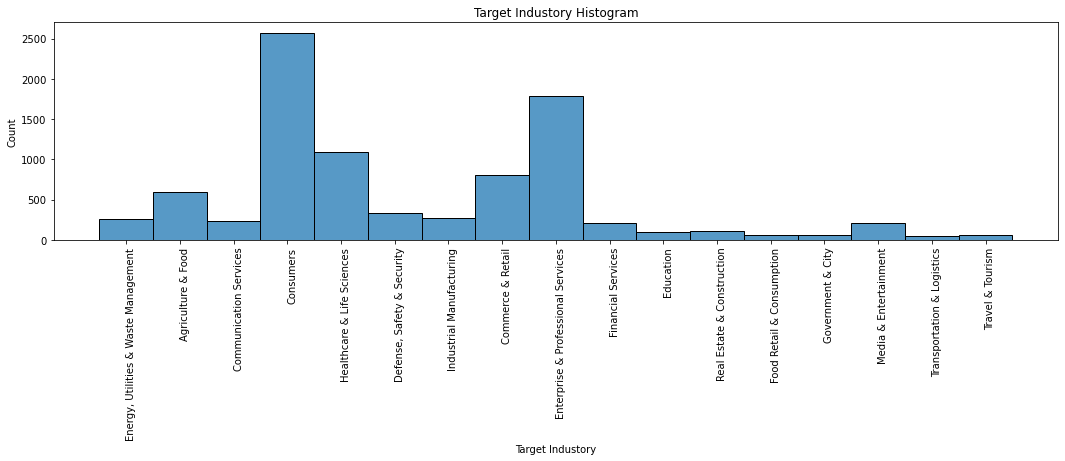
We can seen that the most common sectors are:
1. Consumers
2. Enterprise & Professional Services
3. Life Sciences & HealthTech
We will try to examine information with a large number of columns, to check if the number of companies is divided into several subgroups we will do this using PCA
EDA - Principle Component Analysis (PCA)
Step 1
We create a dataframe containing some numerical variables of our data set:
dataset = df.loc[:,[ 'NEWS_COUNT', 'FOUNDER_COUNT', 'TOTAL_ROUNDS', 'INVESTORS_COUNT','EMPLOYEES','PRODUCT_STAGE']]
dataset.shape
(8821, 6)
Step 2
We now need to create a PCA object, and then call the function that performs PCA on the dataset. the parameter n_componenets, which determines the number of dimesions we would like to have in the end:
pca2 = PCA(n_components=2) #creating a PCA object, while determining the desired number of dimensions
pcComponents = pca2.fit_transform(dataset) #performing PCA using fit_transform on our dataset
PCA creates new axes, hence, new variables - pcComponents is the new numerical data, with two dimensions:
pcComponents.shape
(8821, 2)
Step 3
To make it easy to display our results, we will create a new dataframe with the new features:
principalDf = pd.DataFrame(data = pcComponents, columns = ['principal component 1', 'principal component 2'])
principalDf
| principal component 1 | principal component 2 | |
|---|---|---|
| 0 | -1.057272 | -0.672293 |
| 1 | -0.516033 | -1.171117 |
| 2 | -0.620490 | -1.167730 |
| 3 | 9.815548 | -5.517506 |
| 4 | 4.519727 | -3.071575 |
| ... | ... | ... |
| 8816 | -0.311000 | -0.760671 |
| 8817 | -2.873409 | -0.201562 |
| 8818 | -3.050129 | -0.251598 |
| 8819 | 1.976308 | 4.964279 |
| 8820 | -2.409851 | -0.370227 |
8821 rows × 2 columns
Step 4
We also add the IS_SUCCESSFUL feature, so we will be able to display the data separating successful and unseccessful comapnies:
finalDf = pd.concat([principalDf, df[['IS_SUCCESSFUL']]], axis = 1)
Step 5
We are ready to see our results. We will use a scatterplot:
fig = plt.figure()
ax = plt.axes()
colormap = np.array(['r', 'b'])
ax.scatter(finalDf['principal component 1'], finalDf['principal component 2'], c=colormap[finalDf.IS_SUCCESSFUL])
plt.xlabel('PC1')
plt.ylabel('PC2')
plt.show()
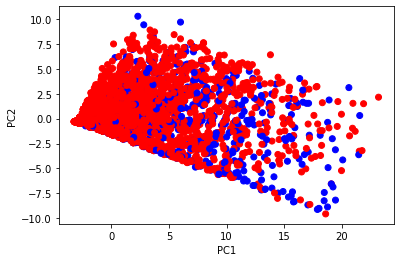
As you can see, we can’t see in this figure a clear separation of successful and unsuccessful companies.
Chi-Square Test of Independence.
We will try to check if there is a relationship between categorical variables.
*EMPLOYEES column
*PRODUCT_STAGE column
ct1 = pd.crosstab(df.PRODUCT_STAGE, df.EMPLOYEES)
ct1
| EMPLOYEES | 0 | 1 | 2 | 3 | 4 |
|---|---|---|---|---|---|
| PRODUCT_STAGE | |||||
| 0 | 196 | 8 | 1 | 0 | 0 |
| 1 | 1084 | 119 | 2 | 0 | 0 |
| 2 | 177 | 65 | 3 | 0 | 0 |
| 3 | 286 | 22 | 1 | 1 | 0 |
| 4 | 700 | 108 | 3 | 0 | 0 |
| 5 | 3234 | 2037 | 601 | 118 | 55 |
chi2_contingency(ct1)
(1071.8373864739401,
1.8320493744078054e-214,
20,
array([[1.31933454e+02, 5.48231493e+01, 1.41996372e+01, 2.76555946e+00,
1.27819975e+00],
[7.75511280e+02, 3.22253146e+02, 8.34661603e+01, 1.62560934e+01,
7.51332049e+00],
[1.57676567e+02, 6.55203492e+01, 1.69702982e+01, 3.30518082e+00,
1.52760458e+00],
[1.99509126e+02, 8.29032989e+01, 2.14726222e+01, 4.18206553e+00,
1.93288743e+00],
[5.21941617e+02, 2.16885727e+02, 5.61751502e+01, 1.09408230e+01,
5.05668292e+00],
[3.89042796e+03, 1.61661433e+03, 4.18716132e+02, 8.15502777e+01,
3.76913048e+01]]))
- We got
- 1071.8373864739401 Chi-Square
- p_vaule < 0.05
- 1071.8373864739401 Chi-Square
- We therefore see that there is a relationship between the variables and they are not independent
- PRODUCT_STAGE column
- EMPLOYEES column
- PRODUCT_STAGE column
- From chi square test we have learned that PRODUCT_STAGE and EMPLOYEES features that the higher number of employees is the higher the product stage is and the opposite claim is also true.
df.to_csv('Data/companies_df/eda_df.csv', index=False)
5. Machine Learning 🤖🤖🤖
df = pd.read_csv('Data/companies_df/eda_df.csv')
To start with the machine learning train and prediction, we need to convert our 4 status columns to ‘is_successful’ column.
sector_replace_map = dict( enumerate(df['SECTOR'].astype('category').cat.categories ))
sector_replace_map = dict([(value, key) for key, value in sector_replace_map.items()])
df['SECTOR'].replace(sector_replace_map, inplace=True)
target_replace_map = dict( enumerate(df['TARGET_INDUSTORY'].astype('category').cat.categories ))
target_replace_map = dict([(value, key) for key, value in target_replace_map.items()])
df['TARGET_INDUSTORY'].replace(target_replace_map, inplace=True)
We need to predict the ‘IS_SUCCESSFUL’ column. Let us separate it and assign it to a target variable ‘y’. The rest of the data frame will be the set of input variables X.
y = df["IS_SUCCESSFUL"].values
x = df.drop(["IS_SUCCESSFUL"],axis=1)
Now let’s scale the predictor variables and then separate the training and the testing data.
#Divide into training and test data
X_train, X_test, y_train, y_test = train_test_split(x, y, random_state=0 ,test_size = 0.3) # 70% training and 30% test
Logistic Regression
clf = LogisticRegression(solver='lbfgs', max_iter=1000)
clf.fit(X_train, y_train)
y_predict = clf.predict(X_test)
acc = clf.score(X_test,y_test)
print(f"Accuracy of our model using logistic regression: {acc}")
Accuracy of our model using logistic regression: 0.8734416320362675
Lets display our predicted result with confusion matrix
y_predict = clf.predict(X_test)
cf_matrix = metrics.confusion_matrix(y_test, y_predict)
ax= plt.subplot()
sns.heatmap(cf_matrix, annot=True, fmt='g', ax=ax, cmap='Blues'); #annot=True to annotate cells, ftm='g' to disable scientific notation
# labels, title and ticks
ax.set_xlabel('Predicted labels');ax.set_ylabel('True labels'); ax.set_title('Confusion Matrix'); ax.xaxis.set_ticklabels(['False','True']);ax.yaxis.set_ticklabels(['False','True']);
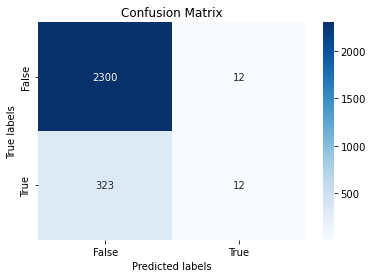
print("accuracy is:",metrics.accuracy_score(y_test, y_predict))
print("precision is:",metrics.precision_score(y_test, y_predict))
print("recall is:",metrics.recall_score(y_test, y_predict))
print("f1 is:",metrics.f1_score(y_test, y_predict))
accuracy is: 0.8734416320362675
precision is: 0.5
recall is: 0.03582089552238806
f1 is: 0.06685236768802229
As we can see the results are not so great, lets try make some changes:
First, We found that ‘TARGET_INDUSTORY’ and ‘FOUNDED_YEAR’ features degrades model performance so we will drop them.
Second, We want to scale our ‘RAISED’ feature because it has very high values.
df.drop(columns = ['TARGET_INDUSTORY'], axis=1, inplace=True)
df.drop(columns = ['FOUNDED_YEAR'], axis=1, inplace=True)
df[['RAISED']] = minmax_scale(df[['RAISED']])
y = df["IS_SUCCESSFUL"].values
x = df.drop(["IS_SUCCESSFUL"],axis=1)
X_train, X_test, y_train, y_test = train_test_split(x, y, random_state=0 ,test_size = 0.3) # 70% training and 30% test
clf = LogisticRegression(solver='lbfgs', max_iter=1000)
clf.fit(X_train, y_train)
y_predict = clf.predict(X_test)
ax= plt.subplot()
cf_matrix = metrics.confusion_matrix(y_test, y_predict)
sns.heatmap(cf_matrix, annot=True, fmt='g', ax=ax, cmap='Blues'); #annot=True to annotate cells, ftm='g' to disable scientific notation
# labels, title and ticks
ax.set_xlabel('Predicted labels');ax.set_ylabel('True labels'); ax.set_title('Confusion Matrix'); ax.xaxis.set_ticklabels(['False','True']);ax.yaxis.set_ticklabels(['False','True']);
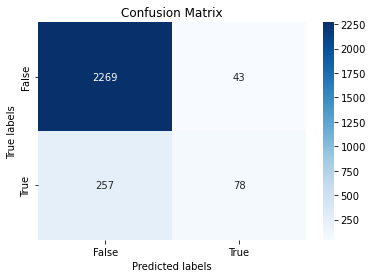
Now lets look at the results again.
print("accuracy is:",metrics.accuracy_score(y_test, y_predict))
print("precision is:",metrics.precision_score(y_test, y_predict))
print("recall is:",metrics.recall_score(y_test, y_predict))
print("f1 is:",metrics.f1_score(y_test, y_predict))
accuracy is: 0.8866641480921799
precision is: 0.6446280991735537
recall is: 0.23283582089552238
f1 is: 0.3421052631578947
As we can see we got about 20-40% higher results!!!
KNN - K-Nearest Neighbors
# set up the model, k-NN classification with k = ?
k = 3
clf = KNeighborsClassifier(n_neighbors=k)
clf.fit(X_train, y_train)
y_predict = clf.predict(X_test)
cf_matrix = metrics.confusion_matrix(y_true = y_test, y_pred = y_predict)
print('Accuracy = ', metrics.accuracy_score(y_true = y_test, y_pred = y_predict))
Accuracy = 0.8587079712882508
Let us take a few possible values of k and fit the model on the training data for all those values. We will also compute the training score and testing score for all those values.
train_score = []
test_score = []
k_vals = []
for k in range(1, 75):
k_vals.append(k)
knn = KNeighborsClassifier(n_neighbors = k)
knn.fit(X_train, y_train)
tr_score = knn.score(X_train, y_train)
train_score.append(tr_score)
te_score = knn.score(X_test, y_test)
test_score.append(te_score)
print(f"Max train_score is: {max(train_score)}\nMax test_score is: {max(test_score)}")
Max train_score is: 1.0
Max test_score is: 0.8745749905553457
plt.figure(figsize=(10,5))
plt.xlabel('Different Values of K')
plt.ylabel('Model score')
plt.plot(k_vals, train_score, color = 'r', label = "training score")
plt.plot(k_vals, test_score, color = 'b', label = 'test score')
plt.legend(bbox_to_anchor=(1, 1),
bbox_transform=plt.gcf().transFigure)
plt.show()
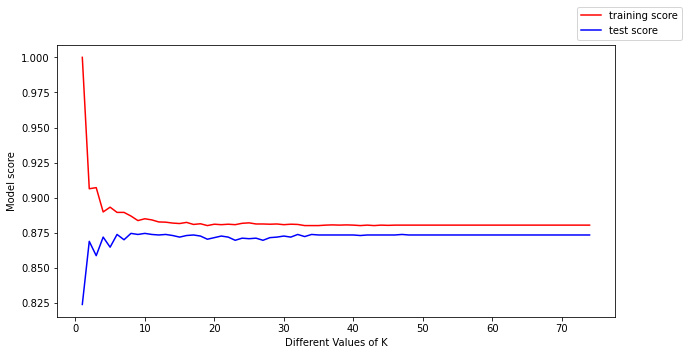
We found the best K for our model!
K = 10
Accuracy = 0.8745749905553457
knn = KNeighborsClassifier(n_neighbors = 10)
#Fit the model
knn.fit(X_train,y_train)
#get the score
knn.score(X_test,y_test)
0.8745749905553457
We can make the following conclusions from the above plot:
- For low values of k, the training score is high, while the testing score is low.
- As the value of k increases, the testing score starts to increase and the training score starts to decrease.
- However, the higher the value of k, both the training score and the testing score are close to each other.
Decision Trees
def splitData(df, features, labels, specifed_random_state=0):
"""Split a subset of the dataset, given by the features, into train and test sets."""
df_predictors = df[features].values
df_labels = df[labels].values
# Split into training and test sets
XTrain, XTest, yTrain, yTest = train_test_split(df_predictors, df_labels, random_state=specifed_random_state)
return XTrain, XTest, yTrain, yTest
def renderTree(my_tree, features):
# hacky solution of writing to files and reading again
# necessary due to library bugs
filename = "temp.dot"
with open(filename, 'w') as f:
f = tree.export_graphviz(my_tree,
out_file=f,
feature_names=features,
class_names=["Perished", "Survived"],
filled=True,
rounded=True,
special_characters=True)
dot_data = ""
with open(filename, 'r') as f:
dot_data = f.read()
graph = pydotplus.graph_from_dot_data(dot_data)
image_name = "temp.png"
graph.write_png(image_name)
display(Image(filename=image_name))
And here you can see the decision tree model with the prediction and accuracy of the training and testing of the model based on ‘NEWS_COUNT’ feature only.
decisionTree = tree.DecisionTreeClassifier()
features = ['NEWS_COUNT']
XTrain, XTest, yTrain, yTest = splitData(df, features, ["IS_SUCCESSFUL"])
# fit the tree with the traing data
decisionTree = decisionTree.fit(XTrain, yTrain)
# predict with the training data
y_pred_train = decisionTree.predict(XTrain)
# measure accuracy
print('Accuracy on training data = ',
metrics.accuracy_score(y_true = yTrain, y_pred = y_pred_train))
# predict with the test data
y_pred = decisionTree.predict(XTest)
# measure accuracy
print('Accuracy on test data = ',
metrics.accuracy_score(y_true = yTest, y_pred = y_pred))
renderTree(decisionTree, features)
Accuracy on training data = 0.8808767951625095
Accuracy on test data = 0.8739800543970988
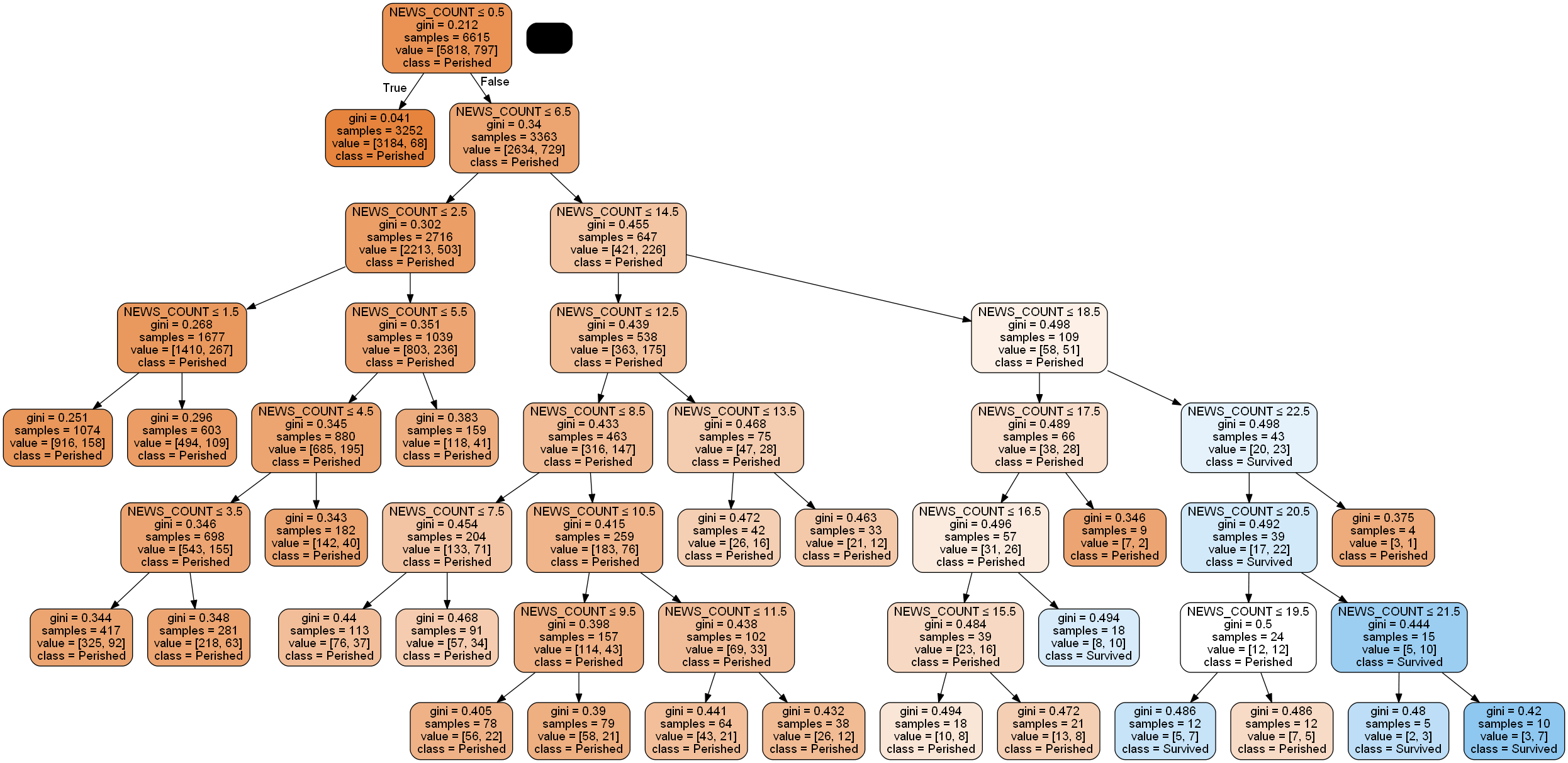
decisionTree = tree.DecisionTreeClassifier()
all_features = df.columns.tolist()
all_features.remove('IS_SUCCESSFUL')
# fit the tree with the traing data
decisionTree = decisionTree.fit(X_train,y_train)
# predict with the training data
y_predict_train = decisionTree.predict(X_train)
# measure accuracy
print('Accuracy on training data = ',
metrics.accuracy_score(y_true = y_train, y_pred = y_predict_train))
# predict with the test data
y_predict = decisionTree.predict(X_test)
# measure accuracy
print('Accuracy on test data = ',
metrics.accuracy_score(y_true = y_test, y_pred = y_predict))
renderTree(decisionTree,all_features)
Accuracy on training data = 1.0
Accuracy on test data = 0.8617302606724594
dot: graph is too large for cairo-renderer bitmaps. Scaling by 0.899402 to fit

OK, clearly, we’re overfitting the data - 100% accuracy on the training data and only ~86% on the test data. Yet, we’ve created a complicated tree.
decisionTree = tree.DecisionTreeClassifier(max_depth=5, min_samples_split=20)
XTrain, XTest, yTrain, yTest = splitData(df, all_features, ["IS_SUCCESSFUL"])
decisionTree = decisionTree.fit(XTrain, yTrain)
y_pred_train = decisionTree.predict(XTrain)
print('Accuracy on training data= ', metrics.accuracy_score(y_true = yTrain, y_pred = y_pred_train))
y_pred = decisionTree.predict(XTest)
print('Accuracy on test data= ', metrics.accuracy_score(y_true = yTest, y_pred = y_pred))
renderTree(decisionTree, all_features)
Accuracy on training data= 0.8946334089191232
Accuracy on test data= 0.8907524932003626

Slight improvement 89% for training and test without overfitting
We got ourselves a better training accuracy but the test prediction did not improve by a noticiable percentage.
Naive Bayes
# Split into training and test sets
y = df["IS_SUCCESSFUL"].values
x = df.drop(["IS_SUCCESSFUL"],axis=1)
XTrain, XTest, yTrain, yTest = train_test_split(x, y, random_state=0, test_size=0.25)
# Instantiate the classifier
gnb = GaussianNB()
gnb.fit(XTrain,yTrain)
y_pred = gnb.predict(XTest)
y_pred_train = gnb.predict(XTrain)
# Print results
print('Accuracy on Train data= ', metrics.accuracy_score(y_true = yTrain, y_pred = y_pred_train))
print('Accuracy on test data= ', metrics.accuracy_score(y_true = yTest, y_pred = y_pred))
Accuracy on Train data= 0.816780045351474
Accuracy on test data= 0.8250226654578422
gnb.class_prior_
array([0.87951625, 0.12048375])
We can see that only about 12% SUCCESSFUL..
In conclusion, we have seen that the algorithms that have brought us the best results are Decision Trees and Logistic Regression with about 89% accuracy.
Credit: part of the code was taken from Data Science course Campus IL
df.to_csv('Data/companies_df/final_df.csv', index=False)